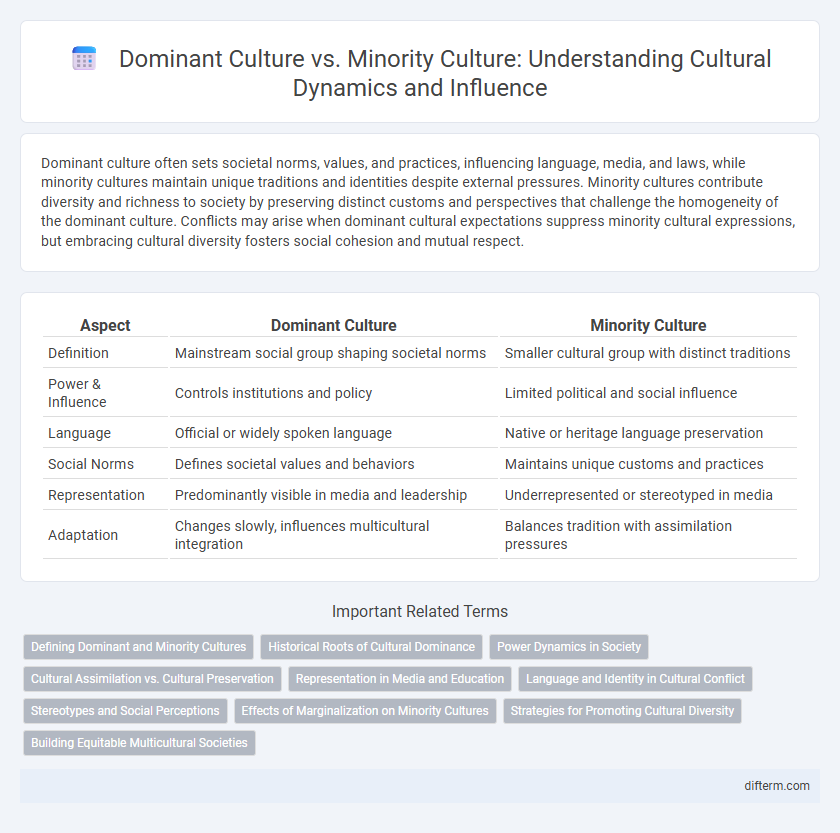Dominant culture often sets societal norms, values, and practices, influencing language, media, and laws, while minority cultures maintain unique traditions and identities despite external pressures. Minority cultures contribute diversity and richness to society by preserving distinct customs and perspectives that challenge the homogeneity of the dominant culture. Conflicts may arise when dominant cultural expectations suppress minority cultural expressions, but embracing cultural diversity fosters social cohesion and mutual respect.
Table of Comparison
| Aspect | Dominant Culture | Minority Culture |
|---|---|---|
| Definition | Mainstream social group shaping societal norms | Smaller cultural group with distinct traditions |
| Power & Influence | Controls institutions and policy | Limited political and social influence |
| Language | Official or widely spoken language | Native or heritage language preservation |
| Social Norms | Defines societal values and behaviors | Maintains unique customs and practices |
| Representation | Predominantly visible in media and leadership | Underrepresented or stereotyped in media |
| Adaptation | Changes slowly, influences multicultural integration | Balances tradition with assimilation pressures |
Defining Dominant and Minority Cultures
Dominant culture represents the prevailing social group whose values, customs, and norms shape societal institutions and public policies, often influencing language, media, and education systems. Minority cultures consist of groups differentiated by ethnicity, language, religion, or customs, typically maintaining distinct identities despite limited social, economic, or political power. Defining dominant and minority cultures involves analyzing power dynamics, access to resources, and cultural visibility within the larger society.
Historical Roots of Cultural Dominance
Dominant culture often emerges from historical contexts of power, colonization, and social hierarchy that prioritize certain groups' customs, languages, and values over others. Minority cultures, shaped by resistance and adaptation, preserve unique traditions despite marginalization and cultural assimilation pressures. The historical roots of cultural dominance reveal ongoing inequalities embedded in institutions, storytelling, and collective memory.
Power Dynamics in Society
Dominant culture shapes societal norms, values, and institutions, often marginalizing minority cultures through control over media, education, and policy-making. Power dynamics manifest in access to resources and representation, privileging dominant groups while limiting social mobility for minorities. Understanding these dynamics is crucial for addressing systemic inequality and fostering inclusive cultural recognition.
Cultural Assimilation vs. Cultural Preservation
Dominant cultures often exert significant influence on minority cultures through cultural assimilation, leading to the adoption of language, customs, and values. Minority cultures emphasize cultural preservation to maintain their unique identity, traditions, and heritage in the face of external pressures. Balancing assimilation and preservation is crucial for fostering multicultural societies that respect diversity and promote social cohesion.
Representation in Media and Education
Representation in media and education crucially shapes the visibility of dominant and minority cultures, with dominant culture often portrayed as the norm, influencing societal perceptions and reinforcing power structures. Minority cultures face underrepresentation or stereotypical portrayals, limiting their opportunities for inclusion and authentic expression. Equitable representation in curricula and media content promotes cultural diversity, fosters mutual respect, and supports social cohesion.
Language and Identity in Cultural Conflict
Dominant culture shapes societal norms and language usage, often marginalizing minority cultures whose languages are critical to their identity and heritage. Language preservation within minority groups serves as a powerful symbol of resistance and cultural pride amid assimilation pressures. Conflicts arise when linguistic differences are politicized, affecting social inclusion and cultural recognition.
Stereotypes and Social Perceptions
Dominant culture often shapes stereotypes that marginalize minority cultures, reinforcing social hierarchies and power imbalances. Minority groups face distorted social perceptions that limit their representation and perpetuate cultural misunderstandings. Challenging these stereotypes requires fostering intercultural dialogue and promoting inclusive narratives.
Effects of Marginalization on Minority Cultures
Marginalization of minority cultures leads to the erosion of language, traditions, and identity, diminishing cultural diversity within society. Social exclusion and limited access to resources contribute to economic disadvantages and reduced political representation for minority groups. Preserving minority cultures requires active policies promoting inclusion, intercultural dialogue, and equitable resource distribution.
Strategies for Promoting Cultural Diversity
Promoting cultural diversity requires implementing strategies that recognize and value the unique contributions of both dominant and minority cultures through inclusive policies and education programs. Encouraging intercultural dialogue and community engagement fosters mutual respect and understanding, helping to dismantle systemic inequalities and cultural biases. Supporting minority cultural expressions in media, arts, and public spaces amplifies diverse voices and strengthens social cohesion.
Building Equitable Multicultural Societies
Dominant culture often shapes societal norms, values, and institutional practices, marginalizing minority cultures whose traditions and perspectives are crucial for cultural diversity. Building equitable multicultural societies requires policies that promote inclusion, protect cultural rights, and encourage intercultural dialogue to dismantle systemic inequalities. Emphasizing cultural competence in education and governance fosters respect and equity, enabling harmonious coexistence and shared societal growth.
dominant culture vs minority culture Infographic

 difterm.com
difterm.com